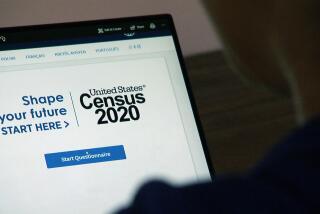Republicans Take Leave of Census in Counting Dispute
- Share via
WASHINGTON — In the information age, we assume that the federal government knows the who, what, when and where of every single citizen. Not true: The U.S. Census Bureau admits that it missed roughly 5% to 6% of minorities in 1980, and even 1% to 2% of the rest.
No count is foolproof, of course. But a widely accepted technique for double-checking is now available to help counters more accurately estimate who is missed by the census. Such precision is vital to a country that bases both its congressional districts and federal budget blueprints on the population survey. As of last fall the Census Bureau was preparing to use a small, but representative, follow-up survey to gauge how many citizens remain uncounted by the 1990 enumeration.
The problem, however is that the Commerce Department blocked the use of readjustment. Departmental officials claimed that the follow-up was “controversial.” It is not hard to discern a GOP motive for blocking the statistical adjustment, since the Reagan Administration doesn’t much like the economics nor the politics that hidden Americans are likely to represent.
The poor and the homeless--those lost in rural shacks and urban tenements--do more than smudge the Administration’s economic image. They do more than represent a potential drain on federal coffers. They tend to vote Democratic.
On Capitol Hill, some members have responded by fighting politics with politics. Rep. Mervyn M. Dymally (D-Compton) and Sen. Daniel Patrick Moynihan (D-N.Y.) have begun pushing a bill that would force the Census Bureau to use the double-check.
The lawmakers are championing their own states’ political agendas, of course. New York, which has witnessed a continuing population decline, is fighting a rear-guard action to prevent the loss of a third congressional seat after the 1990 census. Two House seats from New York already seem destined for extinction.
California, by contrast, is growing fast and is slated to receive greater congressional representation. At least three seats are likely to be added to the current 45-member delegation. A fourth could come after a double-check turns up extra Californians.
The effect on Rust Belt states such as Michigan and Illinois is less clear. Both have significant and concentrated minority populations; both are shrinking and in danger of losing House seats. But whether their congressional delegations will be convinced that a census readjustment would help remains to be seen.
Whichever states are ultimately affected, the common assumption is that the majority of new-found citizens will increase population counts within Democratic strongholds. And, while the amounts in dispute might vary, nobody denies that the impact on federal expenditures could be enormous. With an estimated 500,000 of its residents missed by the 1980 census, for example, New York City complains that it has lost federal revenue-sharing that totals between $26 million and $52 million each year.
The politics of people-counting has been with us for millennia. Long before the decree went out from Caesar Augustus that all the world should be enrolled, many ancient kingdoms used censuses to exert control over certain segments of society: for taxation, conscription or forcible employment. But just like England’s famous Domesday inquest--which was designed to help William the Conquerer figure out who it was he had conquered--most population surveys inadvertently discouraged or intentionally excluded many from being counted. People were afraid of state head-counters, or the state chose to ignore particular heads.
The United States made history in 1790 by creating an ostensibly impartial census as the basis for representative democracy. Article I of the Constitution dictated that House seats and direct taxes would be apportioned according to a census shaped by congressional law.
Enlightened as that development was, it took emancipation to stop the practice of counting a slave as “three-fifths” of a person; American Indians came to be counted only in the 20th Century. Subsequently, lawmakers have mandated the confidentiality of responses, penalties for improper disclosure and sundry other elements to fine tune the nation’s survey.
Just this decade, Congress bowed to another evolution when it authorized a mid-decade census. House districts still will be redrawn only at the decade, but legislators realized that the high craft of demographics has made interim polling truly vital for governmental planners.
Despite all the improvements, however, every U.S. census has suffered from under-count. No matter how extensive the system of safeguards, certain segments of society continue to evade the pollsters. Poverty, frenetic mobility, simple indifference and outright hostility continue to plague counters.
Which is why--partisanship and budget deficits notwithstanding--we need continually to improve our best guess of how many folks are really out there. Its historical significance, not to mention the effect on both taxation and representation, is what makes the integrity of our census so important.
In squashing the use of a follow-up survey last October, Commerce Under Secretary Robert Ortner declared that the existing census was 99% accurate. Any application of a second poll, he said, would constitute “a threat to the customary process of reapportionment.” He called the polling technique “controversial” among statisticians.
Dr. Barbara Bailar knew that was a sham. As the Census Bureau’s associate director for statistical standards and methodology, she understood what was really going on. And she resigned.
“I thought it was a purely political decision,” she says. “Some people did not want those poor and inner-city and minority categories to be increased. And I think it’s obvious that those groups are usually thought of as not voting for the Republican party.”
But what about the controversy over the use of a second survey? “The methodology is not really in dispute by statisticians,” said Bailar. “It’s in dispute by those who are against readjustments.”
This is not sour grapes on Bailar’s part. Michael Wolter did not resign his post as the Census Bureau’s chief of statistical research, yet he agrees that second surveys have been proved effective.
Wolter says that a variety of factors lead to under-counts: fear of government, fear of housing codes or people just plain living in non-standard housing arrangements. As for the accuracy of a follow-up, said Walter: “The consensus, with really only one or two exceptions, is that the methods are available. We can provide an estimate of the total number of people in the country that is closer to the true number than the original census was.”
Indeed, the process is quite simple. After the original census, follow-up surveys are taken among a representative sample of some 300,000 households around the country. Pollsters then measure the statistical sliver of previously unfound people who showed up on the second tally. That yields what Wolter calls “a very conservative assumption” of how many were missed first time around.
Evidently, the assumption is not conservative enough for this Administration. But instead of bowing to executive fiat, Congress should mandate use of the double-check, whether or not it benefits members’ states; it’s just the right thing to do.
More to Read
Get the L.A. Times Politics newsletter
Deeply reported insights into legislation, politics and policy from Sacramento, Washington and beyond. In your inbox twice per week.
You may occasionally receive promotional content from the Los Angeles Times.










